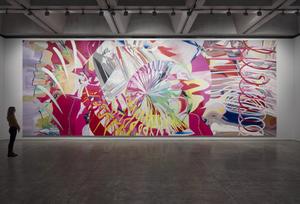James Rosenquist: Two Paintings Kasmin Gallery
October 17 - November 16, 2019
509 West 27th Street, New York, NY
Press Release
Kasmin in cooperation with the Estate of James Rosenquist and Galerie Thaddaeus Ropac (London, Paris, Salzburg), is pleased to announce an exhibition of two important paintings by James Rosenquist. On view at the gallery’s flagship 509 West 27th Street location, both works—Joystick (2002) and The Geometry of Fire (2011)—reflect Rosenquist’s lifelong fascination with space, real and imagined, and his turn in the last two decades of his career to a new kind of abstraction.
Measuring 46 feet across and spanning the length of the gallery’s wall, the monumental Joystick is an ode to Rosenquist’s love of flying. Based on reflections from a mirrored cylinder, packed with gyrating forms that move at incredible speed, the space of Joystick is invented, abstract, and wholly optical. “The priority for me is visual invention and, really, content is secondary,” Rosenquist told the late art historian Robert Rosenblum. By contrast, the central expanse of The Geometry of Fire is a reflection of real space. Painted after a devastating fire destroyed the artist’s Florida studio, the 25 foot long picture depicts the wildness of fire on the left and the destruction it causes, seen in the melting, exploding hub caps on the right. At the picture’s center is the mysterious cosmos, populated with the galaxies, star showers and black holes that became the subject of Rosenquist’s last paintings.
An essay by writer and curator, Judith Goldman, who has written extensively on James Rosenquist, will accompany the exhibition.
ABOUT JAMES ROSENQUIST
One of the most important painters of post-war American Art, James Rosenquist (1933–2017) was born in Grand Forks, North Dakota. He studied painting at the University of Minnesota with Cameron Booth. In 1955, he moved to New York having won a scholarship to the Art Students League, where he studied with Will Barnet, Edwin Dickinson and Robert Beverly Hale, among others. In 1957, he took a job painting billboards, working on scaffolds in Brooklyn and, a year later, high above Times Square. Rosenquist’s first solo exhibition at the Green Gallery in 1962 sold out and established Rosenquist’s reputation as a founding member of the Pop art generation. In 1965, after working a year on the painting, Rosenquist exhibited his iconic F-111, now in the collection of The Museum of Modern Art. F-111 was his first big painting; Joystick (2002) was his last.
James Rosenquist’s work is included in major private and public collections, including the Metropolitan Museum of Art; the Museum of Modern Art; the Whitney Museum of American Art; the Los Angeles Museum of Contemporary Art; the Museum Ludwig, Cologne; the Centre Georges Pompidou, Paris; and the Moderna Museet, Stockholm. He has been the subject of retrospectives at the Whitney Museum of American Art and the Guggenheim Museum. In 2017, the Ludwig Museum organized his most recent retrospective James Rosenquist: Painting as Immersion which traveled to the ARoS Aahus Art Museum, Denmark.

Installation view Joystick, 2002. Oil on canvas, with rope, acrylic rod, and mirrored Plexiglas. 17 ft. 1 1/4 in. x 46 ft. (5.21 x 14.02 m). Collection of the Estate of James Rosenquist. Photo courtesy of Kasmin Gallery. Artwork © James Rosenquist, Inc. / Licensed by Artists Rights Society (ARS), NY. Used by permission. All rights reserved.